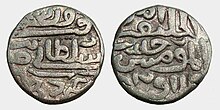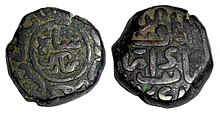Sayyid dynasty
Sayyid dynasty | |||||||||
|---|---|---|---|---|---|---|---|---|---|
| 1414–1450 | |||||||||
 The tomb of Muhammad Shah at Lodi Gardens, New Delhi. | |||||||||
| Capital | Delhi | ||||||||
| Common languages | Persian (official)[1] | ||||||||
| Religion | Sunni Islam | ||||||||
| Government | Sultanate | ||||||||
| Sultan | |||||||||
• 1414–1421 | Khizr Khan Sayyid | ||||||||
• 1421-1434 | Mubarak Shah | ||||||||
• 1434-1443 | Muhammad Shah | ||||||||
• 1443-1451 | Ala-ud-Din Shah | ||||||||
| History | |||||||||
• Established | 28 May 1414 | ||||||||
• Disestablished | 19 April 1450 | ||||||||
| |||||||||
| Today part of | India Pakistan | ||||||||
| Delhi Sultanate |
|---|
| Ruling dynasties |
The Sayyid dynasty was the fourth dynasty of the Delhi Sultanate, with four rulers ruling from 1414 to 1451. The dynasty was founded by Khizr Khan a Punjabi Muslim chieftain belonging to the Khokar clan from Lenhda Punjab (now in Pakistan)[2] [3] and a former governor of Multan under Tughlaq Dynasty.[4]
Khizr Khan was made governor of the Punjabi cities of Lahore, Multan and Dipalpur after the invasion by Timur. In 1414, shortly after the death of the last Tughluq monarch and nearly a decade after Timur’s death, he managed to wrest control of Delhi itself and launch his own dynasty of monarchs. [5] They were succeeded by the Lodi Dynasty.
Members of the dynasty derived their title, Sayyid, or the descendants of the Islamic prophet, Muhammad, based on the claim that they belonged to his lineage through his daughter Fatima, and son-in-law and cousin Ali.
History
Following Timur's 1398 Sack of Delhi,[6] he appointed Khizr Khan as deputy of Multan (Punjab).[7] Khizr Khan captured Delhi on 28 May 1414 thereby establishing the Sayyid dynasty.[7] Khizr Khan did not take up the title of Sultan and nominally, continued to be a Rayat-i-Ala (vassal) of the Timurids - initially that of Timur, and later his grandson Shah Rukh.[8]
Khizr Khan was succeeded by his son Sayyid Mubarak Shah after his death on 20 May 1421. Mubarak Shah referred to himself as Muizz-ud-Din Mubarak Shah on his coins. A detailed account of his reign is available in the Tarikh-i-Mubarak Shahi written by Yahya-bin-Ahmad Sirhindi. After the death of Mubarak Shah, his nephew, Muhammad Shah ascended the throne and styled himself as Sultan Muhammad Shah. Just before his death, he called his son Sayyid Ala-ud-Din Shah from Badaun, and nominated him as successor.[citation needed]
The last ruler of the Sayyids, Ala-ud-Din, voluntarily abdicated the throne of the Delhi Sultanate in favour of Bahlul Khan Lodi on 19 April 1451, and left for Badaun, where he died in 1478.[9]
Kings
Khizr Khan

Khizr Khan was the governor of Multan under Firuz Shah Tughlaq. When Timur invaded India, Khizr Khan, a Sayyid from Multan joined him. Timur appointed him the governor of Multan and Lahore. He then conquered the city of Delhi and started the rule of the Sayyids in 1414. He was ruling in the name of Timur. He could not assume an independent position in all respects. As a mark of recognition of the suzerainty of the Mongols, the name of the Mongol ruler (Shah Rukh) was recited in the khutba but as an interesting innovation, the name of Khizr Khan was also attached to it. But strangely enough, the name of the Mongol ruler was not inscribed on the coins and the name of the old Tughlaq sultan continued on the currency. No coins are known in the name of Khizr Khan.[10]
Mubarak Shah

Mubarak Shah was the son of Khizr Khan, who ascended the throne in the year 1421,unlike his father, he hardly made any attempt in recovering the lost territories of the kingdom.
Muhammad Shah
Muhammad Shah was a nephew of Mubarak Shah. He ruled from 1434–1443. Muhammad Shah acceded to the throne with the help of Sarwar ul Mulk. After that Shah wanted to free himself from the domination of Sarwar ul Mulk with the help of his faithful vizier Kamal ul Mulk. His reign was marked by many rebellions and conspiracies, and he died in the year 1445.
Alam Shah
The last ruler of the Sayyid dynasty, Alauddin Alam Shah was defeated by Bahlol Lodi, who started the Lodi dynasty.
See also
References
- ^ "Arabic and Persian Epigraphical Studies - Archaeological Survey of India". Asi.nic.in. Retrieved 14 November 2010.
- ^ Eaton, Richard Maxwell. India in the Persianate Age: 1000-1765. University of California Press. p. 199. ISBN 0520974239.
- ^ Simon Digby, “After Timur Left: North India in the Fifteenth Century,” in Francesca Orsini and Samira Sheikh, eds., After Timur Left (New Delhi: Oxford U.P, 2014), p. 49
- ^ Cite error: The named reference
“richard-pg199”was invoked but never defined (see the help page). - ^ Eaton, Richard Maxwell. India in the Persianate Age: 1000-1765. University of California Press. p. 200. ISBN 0520974239.
- ^ Jackson 2003, p. 103.
- ^ a b Kumar 2020, p. 583.
- ^ Mahajan, V.D. (1991, reprint 2007). History of Medieval India, Part I, New Delhi: S. Chand, ISBN 81-219-0364-5, p.237
- ^ Mahajan, V.D. (1991, reprint 2007). History of Medieval India, Part I, Now Delhi: S. Chand, ISBN 81-219-0364-5, p.244
- ^ Nizami, K.A. (1970, reprint 2006) A Comprehensive History of India, Vol-V, Part-1, People Publishing House, ISBN 81-7007-158-5, p.631
Sources
- Kumar, Sunil (2020). "The Delhi Sultanate as Empire". In Bang, Peter Fibiger; Bayly, C. A.; Scheidel, Walter (eds.). The Oxford World History of Empire. Vol. Volume Two: The History of Empires. Oxford University Press.
{{cite book}}:|volume=has extra text (help) - Jackson, Peter (2003). The Delhi Sultanate: A Political and Military History. Cambridge University Press.
